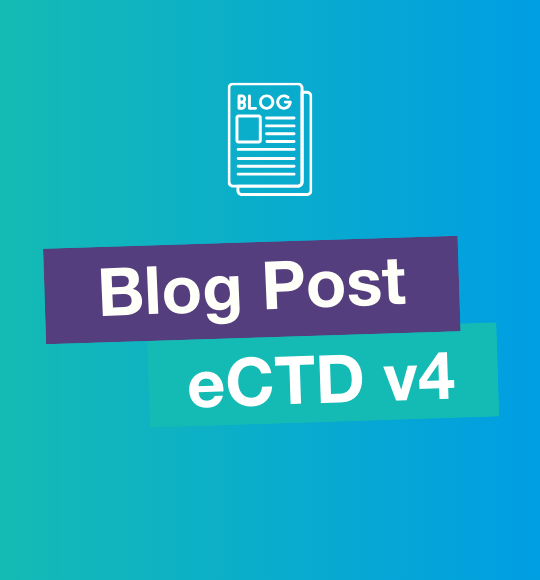
What are the Differences between eCTD v3 and eCTD v4? - A Comprehensive Guide
The differences between eCTD v3 and eCTD v4 are already evident in their architectures: eCTD v4 relies on a flexible, XML-based structure that significantly expands eCTD v3's functionalities. This enables improved file organization, advanced versioning options, increased document reuse, and a more intuitive user experience. With eCTD v4, regulatory professionals benefit from greater efficiency and compliance and faster implementation of future regulations.
Read this blog post to learn more about the key differences between the two versions and find out how eCTD v4 enhances the capabilities of eCTD v3.
What is eCTD?
The electronic Common Technical Document (eCTD) is an internationally recognized standard for the submission and assessment of regulatory applications between the life science industry and health authorities. It streamlines the submission process, making it easier for both life science companies and regulatory authorities to manage and review the extensive documentation involved in drug approvals.
From eCTD v3 to eCTD v4 – What happened?
eCTD has revolutionized the way life science companies submit regulatory documents to health authorities. eCTD version 3 was introduced in the early 2000s and became the globally accepted standard for electronic submissions over the past two decades. With growing complexity in data management, the transition to eCTD v4 started around ten years ago. Since then, regulatory authorities such as the EMA have started piloting the new standard. The shift to eCTD v4 is considered a significant change: it introduces a more flexible, XML-based architecture that enables two-way communication between industry and regulators, enhances lifecycle management, and improves the reuse of submitted data.
With the evolution of eCTD versions, it is essential to understand the differences between eCTD v3 and the more recent v4. Let us have a look at the key differences, benefits, and implications of transitioning from eCTD v3 to eCTD v4.
What are the Key Differences Between eCTD v3 and v4?
Structure and Organization in eCTD v3 and v4:
- eCTD v3: The structure primarily revolves around a hierarchical organization of documents divided into modules, but lacks flexibility in document organization.
- eCTD v4: Introduces a flexible and refined structure that allows for better organization of files. This includes the use of “submissions” and “folders” that can handle more complex applications, reflecting modern regulatory needs.
XML Metadata in eCTD v3 vs XML Metadata in eCTD v4
- eCTD v3: Utilizes XML for metadata but has limitations in how much information can be captured and shared.
- eCTD v4: Enhances XML capabilities, allowing for better quality of metadata by utilizing Controlled Vocabularies that can accommodate more diverse data types. This improves data management and retrieval efficiency.
- eCTD v3: Supports basic version control but can be cumbersome when managing multiple revisions of documents.
- eCTD v4: Offers advanced versioning capabilities, enabling better tracking of changes and facilitating easier updates, which is especially beneficial for ongoing clinical studies and post-marketing submissions.
- eCTD v3: Re-use of documents is limited and often requires duplication of files for different submissions, leading to inefficiencies and potential inconsistencies.
- eCTD v4: Significantly enhances the ability to reuse documents across submissions. This means that companies can reference existing documents without the need to create new copies, streamlining the submission process and ensuring consistency across multiple applications. This capability is particularly advantageous for companies with extensive portfolios or those involved in numerous submissions simultaneously.
- eCTD v3: Utilizes Study Tagging Files (STFs) to associate clinical study data with corresponding regulatory submissions, which can lead to complexity and challenges in document organization
- eCTD v4: Replaces STFs with a more intuitive grouping of documents feature. This allows for a more cohesive organization of related documents without the need for separate tagging files, simplifying the submission process and improving clarity for reviewers.
- eCTD v3: While it was a step towards global harmonization, it often necessitated additional country-specific adaptations.
- eCTD v4: Aims for greater international alignment, making it easier for companies to submit documents across different regulatory jurisdictions without extensive modifications.
- eCTD v3: It was possible to view v3 in a traditional file share structure, although a dedicated viewer is used by many to easily identify the lifecycle operations between documents
- eCTD v4: A viewer is mandatory for users to view an eCTD v4 application, this will enhance the user experience with a more intuitive interface, which simplifies navigation and usability for both submitters and reviewers.

Benefits of Transitioning from eCTD v3 to eCTD v4
- Efficiency Gains: The advanced features of eCTD v4 streamline the submission process, reducing the time taken for document preparation and review.
- Better Compliance: The enhanced metadata and versioning capabilities ensure better compliance with regulatory requirements and facilitate easier audits.
- Future-Proofing Submissions: As the regulatory landscape continues to evolve, eCTD v4 positions companies to adapt to new requirements more swiftly and efficiently.
The transition from eCTD v3 to eCTD v4 represents a significant advancement in regulatory submission processes, reflecting the industry's need for improved efficiency, flexibility, and compliance. As life science companies prepare for this shift, understanding the differences and benefits of eCTD v4 will be crucial in ensuring successful submissions and maintaining competitive advantages in the marketplace.
As always, staying informed and adapting to new technologies will be key for organizations looking to navigate the complexities of regulatory submissions effectively.
FAQs about the differences between eCTD v3 to eCTD v4:
1. What is the main structural difference between eCTD v3 and eCTD v4?eCTD v3 uses a hierarchical structure with limited flexibility, while eCTD v4 offers a more adaptable format with "submissions" and "folders" for better organization of complex applications.
2. How does XML metadata differ between eCTD v3 and eCTD v4?
eCTD v3 has limited XML metadata capabilities, whereas eCTD 4.0 enhances these to support better quality of metadata for improved data management and retrieval.
3. What improvements does eCTD v4 offer in document versioning and reuse?
eCTD v4 features advanced versioning for easier tracking and updates, benefiting ongoing studies. It also allows for better reuse of documents across submissions, reducing duplication and ensuring consistency.
4. How does eCTD v4 simplify document organization compared to eCTD v3?
eCTD v4 replaces US FDA Study Tagging Files (STFs) with an intuitive document grouping feature, improving clarity and organization without separate tagging.
5. How does the user experience differ between eCTD v3 and eCTD v4?
eCTD v3 can be viewed in a traditional file share structure or via a viewer. eCTD v4 requires a dedicated viewer; however provides a more user-friendly interface that simplifies navigation for both life science submission and health authority assessment.
6. What are the key benefits of transitioning from eCTD v3 to eCTD v4?
Transitioning to eCTD v4 improves submission efficiency, enhances regulatory compliance, and offers better adaptability to future changes, positioning companies for success.

.png)
.png)
